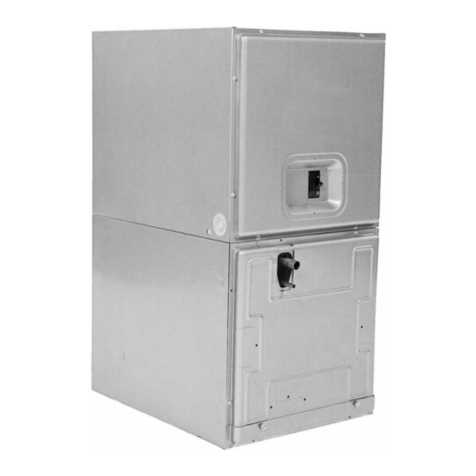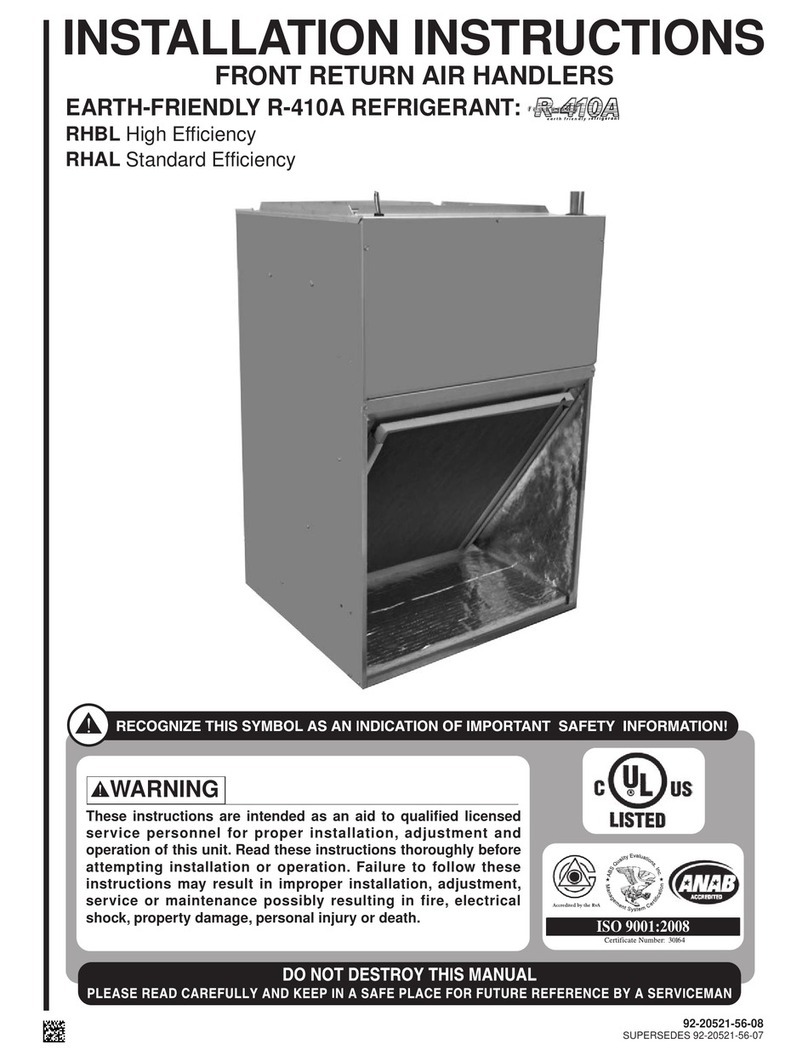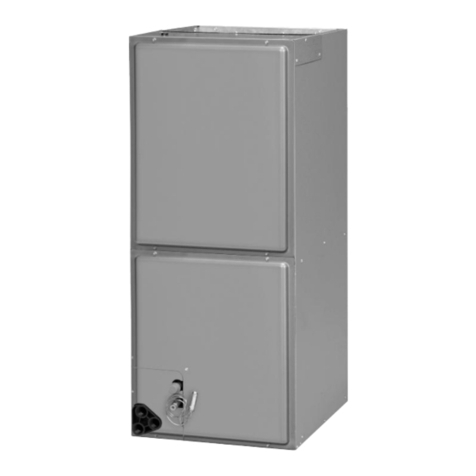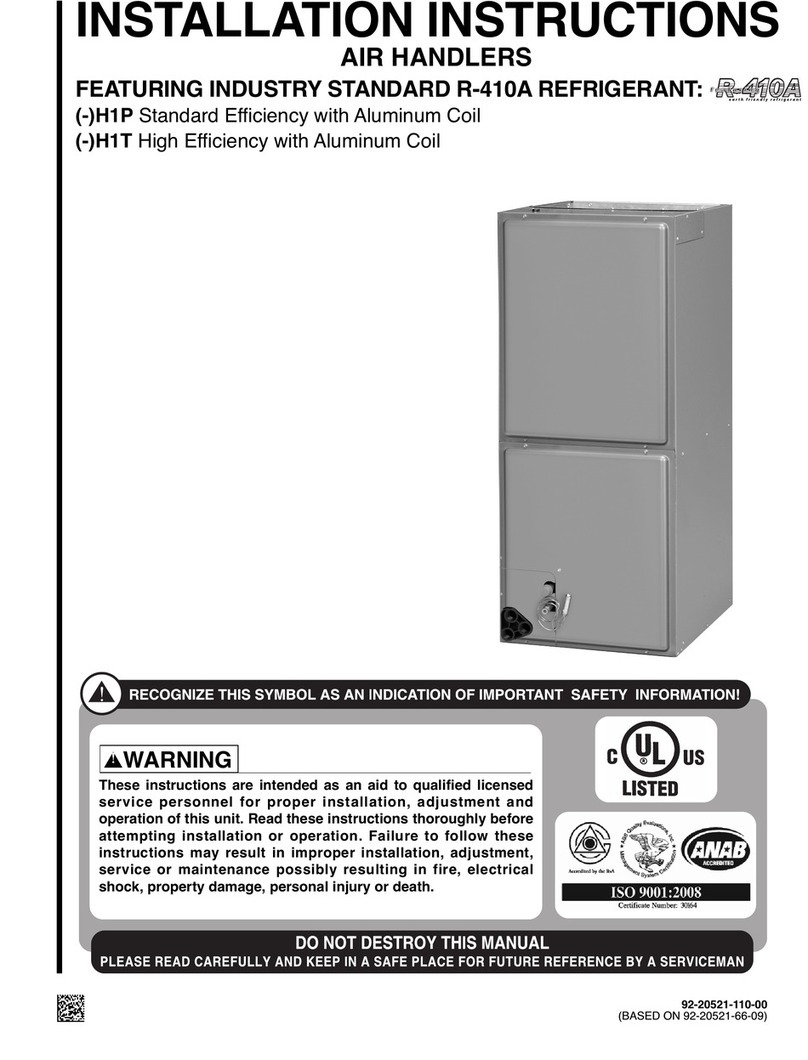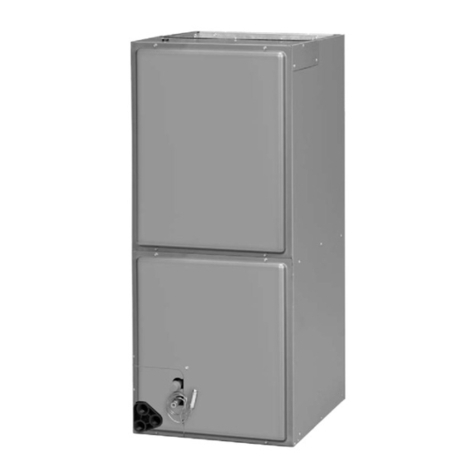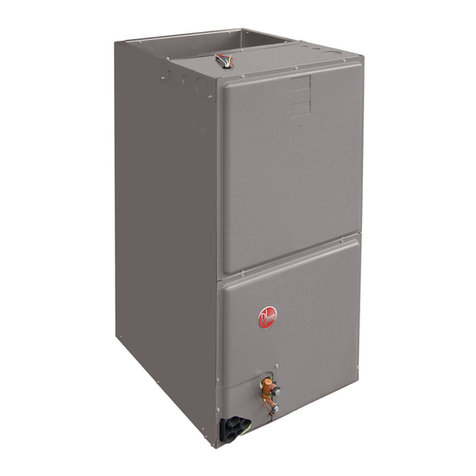
6
Association, Inc., Batterymarch
Park, Quincy, MA 02269.” These
publications are:
• ANSI/N PA No. 70-(Latest Edition)
National Electrical Code.
• N PA90A Installation of Air
Conditioning and Ventilating
Systems.
• N PA90B Installation of Warm Air
Heating and Air Conditioning
Systems.
• The equipment has been
evaluated in accordance with the
Code of ederal Regulations,
Chapter XX, Part 3280.
IMPORTANT INFORMATION
ABO T EFFICIENCY AND
INDOOR AIR Q ALITY
Central cooling and heating
equipment is only as efficient as the
duct system that carries the cooled or
heated air. To maintain efficiency,
comfort and good indoor air quality, it
is important to have the proper
balance between the air being
supplied to each room and the air
returning to the cooling and heating
equipment.
Proper balance and sealing of the
duct system improves the efficiency
of the heating and air conditioning
system and improves the indoor air
quality of the home by reducing the
amount of airborne pollutants that
enter homes from spaces where the
ductwork and/or equipment is
located. The manufacturer and the
U.S. Environmental Protection
Agency’s ENERGY STAR Program
recommend that central duct systems
be checked by a qualified contractor
for proper balance and sealing.
DUCT LEA S CAN CREATE AN
UNBALANCED SYSTEM AND
DRAW POLLUTANTS SUCH AS
DIRT, DUST, FUMES AND ODORS
INTO THE HOME CAUSING
PROPERTY DAMAGE. FUMES
AND ODORS FROM TOXIC,
VOLATILE OR FLAMMABLE
CHEMICALS, AS WELL AS
AUTOMOBILE EXHAUST AND
CARBON MONOXIDE (CO), CAN
BE DRAWN INTO THE LIVING
SPACE THROUGH LEA ING
DUCTS AND UNBALANCED DUCT
SYSTEMS CAUSING PERSONAL
INJURY OR DEATH (SEE FIGURE
2).
• IF AIR-MOVING EQUIPMENT OR
DUCTWOR IS LOCATED IN
GARAGES OR OFF-GARAGE
STORAGE AREAS - ALL JOINTS,
SEAMS, AND OPENINGS IN THE
EQUIPMENT AND DUCT MUST
BE SEALED TO LIMIT THE
MIGRATION OF TOXIC FUMES
AND ODORS INCLUDING
CARBON MONOXIDE FROM
MIGRATING INTO THE LIVING
SPACE.
• IF AIR-MOVING EQUIPMENT OR
DUCTWOR IS LOCATED IN
SPACES CONTAINING FUEL
BURNING APPLIANCES SUCH
AS WATER HEATERS OR
BOILERS - ALL JOINTS, SEAMS,
AND OPENINGS IN THE
EQUIPMENT AND DUCT MUST
ALSO BE SEALED TO PREVENT
DEPRESSURIZATION OF THE
SPACE AND POSSIBLE
MIGRATION OF COMBUSTION
BYPRODUCTS INCLUDING
CARBON MONOXIDE INTO THE
LIVING SPACE.
IMPROPER INSTALLATION, OR
INSTALLATION NOT MADE IN
ACCORDANCE WITH THE UL
CERTIFICATION OR THESE
INSTRUCTIONS, CAN RESULT IN
UNSATISFACTORY OPERATION
AND/OR DANGEROUS CONDI-
TIONS AND ARE NOT COVERED BY
THE UNIT WARRANTY.
IN COMPLIANCE WITH
RECOGNIZED CODES, IT IS
RECOMMENDED THAT AN
AUXILIARY DRAIN PAN BE
INSTALLED UNDER ALL
EVAPORATOR COILS OR UNITS
CONTAINING EVAPORATOR COILS
OR AIR HANDLERS USED WITH
EVAPORATOR COILS THAT ARE
LOCATED IN ANY AREA OF A
STRUCTURE DAMAGE TO THE
BUILDING OR BUILDING CONTENTS
MAY OCCUR AS A RESULT OF AN
OVERFLOW OF THE COIL DRAIN
PAN OR A STOPPAGE IN THE
PRIMARY CONDENSATE DRAIN
PIPING.
required for the job specification.
• Read the entire instructions before
starting the installation.
• Some building codes require extra
cabinet insulation and gasketing
when unit is installed in attic
applications.
• If installed in an unconditioned
space, apply caulking around the
power wires, control wires,
refrigerant tubing and condensate
line where they enter the cabinet.
Seal the power wires on the inside
where they exit conduit opening.
Caulking is required to prevent air
leakage into and condensate from
forming inside the unit, control box,
and on electrical controls.
• Install the unit in such a way as to
allow necessary access to the
coil/pump and blower/control
compartment.
• Install the unit in a level position to
ensure proper condensate
drainage. Make sure unit is level in
both directions within 1/8”.
• Install the unit in accordance with
any local code which may apply
and the national codes. Latest
editions are available from:
“National ire Protection
RECEIVING
Immediately upon receipt, all cartons
and contents should be inspected for
transit damage. Units with damaged
cartons should be opened
immediately. If damage is found, it
should be noted on the delivery
papers, and a damage claim filed
with the last carrier.
• After unit has been delivered to job
site, remove carton, taking care
not to damage unit.
• Check the unit rating plate for unit
size, voltage, phase, etc. to be
sure equipment matches what is
NOTICE
NOTICE
!WARNING
FIGURE 3
MIGRATION OF DANGEROUS SUBSTANCES, FUMES, AND ODORS INTO LIVING SPACES


















